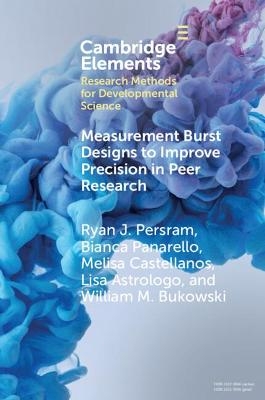
Measurement Burst Designs to Improve Precision in Peer Research
Seiten
2021
Cambridge University Press (Verlag)
978-1-108-98652-6 (ISBN)
Cambridge University Press (Verlag)
978-1-108-98652-6 (ISBN)
Measurement burst designs can be used as a novel method to improve the stability of basic measures typically used in longitudinal peer research. We hypothesized that the stabilities for adolescent-reported peer acceptance, anxiety, and self-concept would be stronger when using the measurement burst approach versus the single time observation.
Measurement burst designs, in which assessments of a set of constructs are made at two or more times in quick succession (e.g., within days), can be used as a novel method to improve the stability of basic measures typically used in longitudinal peer research. In this Element, we hypothesized that the stabilities for adolescent-reported peer acceptance, anxiety, and self-concept would be stronger when using the measurement burst approach versus the single time observation. Participants included youth between 10 and 13 years old who completed (a) sociometric assessments of acceptance, and measures of (b) social and test anxiety, and (c) self-concept across three times with two assessments made at each burst. Findings broadly showed that the stabilities were significantly stronger with the measurement burst when compared to the single time assessment, supporting our main hypothesis. We discuss the utility of the measurement burst in a broader context and considerations for researchers.
Measurement burst designs, in which assessments of a set of constructs are made at two or more times in quick succession (e.g., within days), can be used as a novel method to improve the stability of basic measures typically used in longitudinal peer research. In this Element, we hypothesized that the stabilities for adolescent-reported peer acceptance, anxiety, and self-concept would be stronger when using the measurement burst approach versus the single time observation. Participants included youth between 10 and 13 years old who completed (a) sociometric assessments of acceptance, and measures of (b) social and test anxiety, and (c) self-concept across three times with two assessments made at each burst. Findings broadly showed that the stabilities were significantly stronger with the measurement burst when compared to the single time assessment, supporting our main hypothesis. We discuss the utility of the measurement burst in a broader context and considerations for researchers.
1. Measurement Burst Designs and Peer Relations; 2. Sociometric Assessments and Peer Acceptance; 3. Experiences with Social and Test Anxiety; 4. Assessing Domain-Specific Features of the Self-Concept; 5. Discussion and Concluding Thoughts; Appendix.
| Erscheinungsdatum | 18.10.2021 |
|---|---|
| Reihe/Serie | Elements in Research Methods for Developmental Science |
| Zusatzinfo | Worked examples or Exercises |
| Verlagsort | Cambridge |
| Sprache | englisch |
| Maße | 152 x 228 mm |
| Gewicht | 145 g |
| Themenwelt | Geisteswissenschaften ► Psychologie ► Entwicklungspsychologie |
| ISBN-10 | 1-108-98652-8 / 1108986528 |
| ISBN-13 | 978-1-108-98652-6 / 9781108986526 |
| Zustand | Neuware |
| Haben Sie eine Frage zum Produkt? |
Mehr entdecken
aus dem Bereich
aus dem Bereich
Vormals Oerter & Montada
Buch | Hardcover (2018)
Julius Beltz GmbH & Co. KG (Verlag)
CHF 89,60
Grundlagen, Diagnostik und Therapie vom Säuglingsalter bis zum alten …
Buch | Hardcover (2022)
Klett-Cotta (Verlag)
CHF 62,95
praktische Hilfen für Kinder und Jugendliche im Autismus-Spektrum
Buch | Softcover (2023)
Kohlhammer (Verlag)
CHF 43,40


